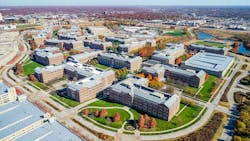Retrofits for Decarbonization: Two Carbon-Cutting Projects
Decarbonization of the built environment is a growing concern for lawmakers, with jurisdictions across the U.S. and Canada publishing plans to greatly improve energy efficiency and wean existing buildings off fossil fuels.
As Architecture 2030 explains, to completely decarbonize the building sector, all existing buildings will need energy upgrades that involve a combination of:
- More energy-efficient building operations
- Changing to electric or district heating systems powered by carbon-free renewable energy
- Generating or procuring carbon-free renewable energy
These two projects demonstrate progress toward these goals for the building sector.
The Aspiria Campus: Digital-First Decarbonization
The sprawling Aspiria office complex in Overland Park, Kansas, transformed its 200-acre campus with a mission of sustainability, efficiency and reliability. Modernizing its building management system with Schneider Electric’s EcoStruxure solutions, as well as strategic retrofits, allowed the campus to achieve a 16% annual reduction in energy consumption and a 36% reduction in its carbon footprint, as well as saving $1.5 million in annual energy savings.
The campus includes 20 Class A office buildings with more than 30 tenants, noted Rohan Kelkar, EVP of power products for Schneider Electric. Schneider worked with local partner C&C Group, which is certified as an EcoXpert partner in deploying the EcoStruxure suite, to integrate the necessary building management upgrades.
“They wanted the campus energy consumption to be as efficient as possible, keep energy costs low and make the buildings more comfortable to work in,” Kelkar explained.
The new building management system offers energy insights in near real-time and also integrates with some of the building systems, which helps optimize energy management and simplifies control. It collects data from sensors, devices and equipment in a centralized hub, which then identifies patterns and helps human workers prioritize maintenance tasks.
Aspiria’s sustainability success, powered by its building management solution, is an example of what can be achieved in the built environment with the right strategy. Planning for the future by making smart investments today is an important part of decarbonizing, Kelkar said.
“If you don’t already have an investor, tenant, or employee who’s asking you to think about decarbonization, you should expect that in the next 12 to 24 months. You’ll be required to do it one way or another, so take the plunge now,” Kelkar said. “The common misconception is that it’s going to be expensive and cost you more, but if you plan smart, it can actually reduce your consumption and more than pay you back.”
River Trails School District: Net Zero at an Affordable Cost
The school district in Mount Prospect, Illinois, needed to renovate a school building dating back to 1966. Prairie Trails School “had old ventilators, the original boiler and it just didn’t perform,” explained Lyndl Schuster, assistant superintendent for business services/CSBO for the River Trails School District. It was time for a makeover—a big one. The district decided to make the building, which now houses a preschool, kindergarten and administration space, net zero for both carbon and energy.
Net zero operation is a lofty goal that requires the right project team. The district hired the engineering firm IMEG to manage the retrofit and the ensuing net zero certification through Phius. IMEG worked closely with Trane to reshape the old building into a model of sustainable operation. The school district was also aided by a $2 million grant from the Illinois Clean Energy Foundation, which helped pay for envelope improvements, solar panels and the new HVAC system, Schuster said.
The school’s original envelope included brick facing, cinder block and an air gap; early steps by the project team beefed up this exterior and added insulation. The heating and cooling system was also a high priority. IMEG reviewed HVAC systems with Trane and ultimately decided to implement a variable refrigerant flow (VRF) system that didn’t require bulky ductwork.
“VRF has the maximum efficiency and coefficient of performance metrics to the minimum footprint impact and cost impact,” explained Austin Fiegel, controls sales engineer for Trane Chicago. “It became the clear winner very quickly.” The HVAC setup also includes air-source heat pumps in the rooftop units.
Controls are also a vital part of managing the school’s energy consumption. The controls platform, supplied by Trane, features programs and sequences customized for the function of each building area. Different areas run on different schedules according to their energy needs and uses. The controls system even discovered an issue with the heat pumps in the rooftop units that was causing higher-than-expected energy use.
“The units were defaulting to electric resistance heat as the first stage of heat, as opposed to using the heat pump portion of the rooftop unit. That was causing us to use more energy,” said Jeff Oke, senior principal and senior client executive for IMEG. “Once we got that corrected, we were more aligned with what we predicted the energy use would be and we were able to achieve the 12 straight months of operating at net zero.” Phius requires a year’s worth of net zero operation to achieve net zero certification.
Net zero projects are a major undertaking, but as the success of River Trails shows, the right team can meet the requirements and achieve project goals.
“Dream big,” advised Mitchell Kelley, new system sales and team leader for Trane Commercial HVAC North America. “No matter what your building type is, no matter how old it is or the infrastructure you currently have, your building is a blank canvas.”
About the Author
Janelle Penny
Editor-in-Chief at BUILDINGS
Janelle Penny has been with BUILDINGS since 2010. She is a two-time FOLIO: Eddie award winner who aims to deliver practical, actionable content for building owners and facilities professionals.

